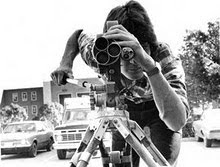Well, I've discovered there is no one place to start for everyone because everyone's demands on a DAM system will be different.
However, I've also discovered that there are many things we all have in common. Where I will start is with those elements. Also, if one identifies one's priorities then a course can be designed and implemented based on what is most important.
I will make recommendations for getting under way assuming a few things.
- The reader is a photographer or a librarian
- The reader has a collection of old images to catalog
- The reader will need to add new images on a continual basis to this collection
- The reader will want to share the images with others
We will learn about digitizing images which are not presently in digital format. We will discuss ways of relating existing analog (film, print, video, text, audio) pieces with digital files which are produced in order to permit their inclusion is a DAM system.
We will learn the terminology of DAM. It's not hard, just different.
We will learn about the ways of marking files (for files are what the digtal assets are) so that they can be searched for. Basically this is the addition of metadata.
There it is.
The first term which actually is pretty discipline specific.
Rarely would you make reference to metadata outside of a discussion of file management or file creation. Metadata is basically data or information about other data or information. Metadata is what enables one to do an internet search for example. What you type into the search engine are basically keywords. A distinct type of metadata. Keyword is an easily understood word with a universal meaning which can be known by understanding the roots it is made up of. I know this is an extremely elementary thing to point out, but it is the distinction between more or less universally understood words and phrases and the discipline specific jargon that is key to developing a working vocabulary for a student. Jargon and acronyms are largely created by engineers who typically are unconcerned with anyone's understanding of their work but other engineers. So they make up contextually relevant terms which are sometimes a puzzle to everyone else. A bit of a pet peeve of mine.
There really are a lot of catch phrases and methodologies involved in DAM which are thrown about by people in the industry. This drove me nuts before I got up to my elbows in them and came to know what they meant. I will build a comprehensive glossary which will help the student of DAM to quickly interpret these so as not to be frustrated by the barrier of meaningless acronyms and "made up" words which have no universal relevance. Things such as JBOD. Which is a technical term for a storage system in a computer network which consists of "Just a Bunch Of Discs". On many hard drive racks which permit one to interchange discs connected to a network, the term JBOD is actually printed on the exterior of the housing next to the appropriate interface socket for just this kind of network. (More about networks later).
We will learn about file storage; digital and analog. We will discuss protocols for storage and distribution. We will discuss something which could be a subject of study and a discipline unto itself "Workflow".
There is a distinction between workflow and digital asset management. Workflow incorporates digital asset management as a key component. Workflow involves a few things that can be left out of a conversation about digital asset management, but it is important to have a workflow in order to make digital asset management work for you.
So ...
A bit of an introduction "fleshed out" for you. A feel for how I will write this blog and an indication of where I'm going.
Don't hesitate to identify areas you feel I may be ignoring as I go along.
I know what I know, and I use what I know. I hope you can see things you can relate to and that if I am missing something you would like comments on that you will contact me and let me know.
More coming soon. Much sooner than the time between this posting and the previous one.
Thanks for the push ... you know who you are.
